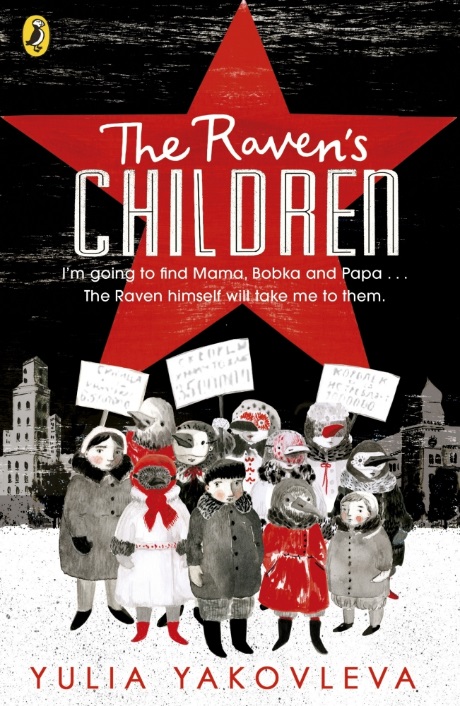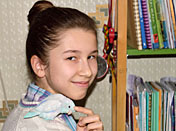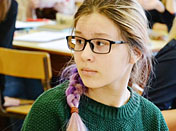
The Raven’s Children, the first book of Yulia Yakovleva’s The Leningrad Tales series, addresses the topic of the Stalin’s Purge and of how political repression affects the fates of children. We invite you to read what Russian teeangers have to say about this book [published in English by Puffin Books, ISBN 9780241330777].

Ksenia Barysheva, 13
I was heading home from Grandma’s house. The dusty commuter bus turned from the highway onto the country road to pick up passengers from the small village. It stopped by the pond, waited, then turned back around. The elderly woman sitting next to me sighed. “My Grandma and I used to walk here together. She showed me the place where her grandfather’s house once stood and where his big family used to live. I was little and tired and really thirsty. I can barely remember anything she wanted to tell me. She probably didn’t even say very much. Those were the days when you weren’t supposed to know who your ancestors were.”
I didn’t say anything. My grandfather used to tell me that just before the World War II, when his father, my great-grandfather, was just a teenager, everyone in his village was loaded up onto trains and taken to Yaroslavl. For two days, the villagers awaited a decision about their resettlement. But things didn’t go according to plan and everyone was allowed to go home. Who was giving orders then? Who’s will was it that people, whole families, and even whole villages would vanish without a trace?
Shurka, the hero of The Raven’s Children by Yulia Yakovleva, amuses himself by going to the railway station with his friend Valka to lay nuts and bolts out on the tracks and watch them get flattened by the passing trains. Sneaking along the tracks, careful so that a policeman wouldn’t see them, they reach a freight train on the storage lane and see something that makes them forget all about the nuts and bolts. People are peering out at them through the cracks in the train cars. Who are they? Why are there so many of them and why are they being transported in freight trains? Why are the tracks watched so closely by police? A crumpled scrap of paper flutters out onto the ground and Shurka hides it in his pocket. “Tell them... 5 Sadovaya Street... taken to Kolyma Gulag…” Shurka’s father later reads these blurred lines on the paper that has fallen from his son’s pocket. He turns pale. He burns it. “‘What’s that smell of burning?’”, asks Tanya, Shurka’s older sister, when she comes home from school. “‘Your father’s been burning some old papers,’ Mama hurriedly explained.” And someone’s last chance to reach their loved ones vanishes along with the smoke.
Papa explains to Shurka that there are traitors and spies trying to hurt the nascent Soviet government. There’s been an arrest at his work. These people, who are being sent to correctional camps, throw notes from the train cars to cause trouble for those who pick them up.
Shurka, Tanya, their parents, and their younger brother Bobka live in Leningrad, in a communal apartment, two rooms across from one another at the end of a hallway. In order to avoid having to go from room to room through the hallway, Papa has made a door in the wall between the rooms and covered it with a closet that opens in both directions. One morning, when they walk through the doors of the closet into their parents’ room, Shurka and Tanya discover that their father has disappeared. Mama tears the old photographs with smiling faces to shreds and explains that he’s left on a business trip and should return soon. But the neighbors are whispering something behind the children’s backs. The next morning Mama and Bobka disappear. The closet fooled those who came for the rest of the family and Tanya and Shurka were spared. The old-lady neighbor throws the kids a purse their mother left them and tells them that Mama asked them to go to her sister Aunt Vera’s. The children hear the neighbors say that their parents were taken away by the “black raven” [ed. note: cherny voron in Russian], but they don’t know what that means. (Black voronoks were what people called the special automobiles used to transport people arrested by the NKVD, the People's Commissariat for Internal Affairs, a government agency that investigated crimes against the state, sentenced people without the right to appeal, and enforced the harsh sentences.)
Happy in their unexpected freedom, the children walk about the city. They are sure that everything will be right again by evening: Mama will come home from work, Bobka will be back from preschool, and even Papa may return from his sudden business trip. On the corner of Nevsky Prospect, they buy cakes in nice wrappers and hurry home… But their rooms are now occupied by the neighbors and the children are not allowed in the apartment. They sleep in the attic. In the morning, when Shurka asks the building caretaker where his parents went, the man calls the police. As the kids flee, Shurka pushes Tanya into a building and turns to face his pursuers. Tanya is able to hide and she makes it to Aunt Vera’s. Her brother ends up in an orphanage, where he gets a new name and is forced to forget about his past. There, they keep telling him he should be grateful to the government for taking care of him, the child of enemies of the people and traitors of the Homeland.
Shurka is able to escape from the orphanage. As he searches for his parents, he sees kilometer-long lines to the gates of detention facility—lines of people who, like him, just want to learn what became of their loved ones. In line, Shurka meets Lena, a young woman whose husband has been arrested. The boy tries to get in and he ends up on the other side of the gates. He watches as letters begging for information or pardon are thrown into a furnace by the bagful. He understands that he can’t count on help from this place and wanders away in despair. Lena runs after him. She is one of the lucky ones: she has learned that her husband’s sentence is ten years, without the right to correspondence. The young woman thinks ten years is just a short time in the face of love and that she will wait it out for her husband. She hurries home, leaving Shurka alone again.
He meets other homeless children—the “kings of the streets,” children without a past who insist that they don’t have and have never had parents and that their city is not Leningrad but another city altogether, a ghost-city where they go unnoticed and can steal from the groceries and markets and sleep in attics. In the real Leningrad, Shurka lived in an apartment with a white grand piano, took violin lessons, and had warm milk and cookies before bed. Now, he feels that he’s starting to dissolve in this strange city, where nobody cares what becomes of him.
As winter nears, the King of the streets asks Shurka to show him the orphanage, where they can spend the winter without freezing. But Shurka doesn’t want to go back there, to the place where they forced him to forget his family. He understands that the King is actually very lonely and that his independence brings him no happiness, since it comes from hatred and anger at the way his happy life abruptly ended. The King believes that the past fooled him by giving him a home, safety, and his parents’ love.
When he sees a group of children happily marching outside, Shurka suddenly understands why the raven takes parents away. He needs children. Children, whose past can be taken away from them, and who can be brainwashed and made to forget about themselves. Children can be ordered into line and made to behave. He understands that he needs to save his younger brother Bobka who may also forget about himself, his parents, and his siblings at the orphanage. Shurka goes to Lena, the young woman he met in line to the detention facility, hoping that she will help him learn of Bobka’s fate. In Lena’s room, he sees an overcoat with the insignia of the NKVD. With a bitter laugh, Lena says that ten years is actually a very long time—a time one needs to somehow survive without disappearing along with the rest. Shurka understands that the Raven got Lena too, but in a different way. But she doesn’t turn him in and even tells him where to find Bobka.
The boy sneaks into Bobka’s orphanage to get his brother back. That’s where Aunt Vera, their mother’s sister, finds them. She has managed to get custody of the children and Tanya, Shurka, and Bobka are finally reunited.
The Raven’s Children is a book about political repression, the destruction of people who hold memories of the past, the destruction of those who remember the right to free expression, the meanings of conscience, compassion, and charity. It’s about a generation without a country to stand behind it, a generation deprived of its memory of the past.
The woman on the bus was silent for a bit and then sighed. “Now I’m a grandma myself. I’m on my way to babysit my granddaughter. I’ve asked my daughter so many times to go to the archives, to find at least something about our family, but she waves it away, says she doesn’t have the time. Maybe my granddaughter will go, once she grows up.”


Bogdan Ivanov, 15
For me, the word “fairy tale” calls to mind a sweet children’s story with a colorful setting, unusual characters, and that indispensable happy ending. The way I see it, fairy tales are so full of magic and a particular charm because they originate in a time when natural phenomena were explained not with science or rationalism but with the help of unknown forces and superstition.
So what happens when the fairy tale is set in a modern city with concrete tower blocks and the characters’ fates unfold in accordance with the politics of those in power? The feel of the story turns dark, its setting drained of color. I suppose that’s what Yulia Yakovleva’s The Raven’s Children is like. The book is a sort of fairy tale, but one based on real historical events, specifically Stalin’s Purge. It’s not what you’d call a children’s topic. But the story told in the book is not so much about the Purge as the children who lost their parents to it. They were left all on their own, without friends or anyone to stand up for them, since no one wanted to help those whose parents had been named as spies or “enemies of the people.” No one wanted to bring trouble upon themselves and end up with the same fate. Worst of all was that the children didn’t know where their parents were and why they were considered enemies.
The book conveys this climate of uncertainty. All the orphans know about the disappearance of their parents is that a so-called “Black Raven” has taken them away. The very mention of the Raven incites fear and makes people quickly retreat, without explaining anything to the unfortunate children. The Black Raven, or rather, the black voronok, referred at that time to the special black automobile that the state’s security agency came in, usually at night, to make arrests. The book is packed with such metaphors that tie it to reality and make the author’s intention clear. Those who are familiar with history will understand those references, while most children, like the protagonists of the book, will take them literally.
At first, I didn’t see any indication that the book was a fairytale. Everything appeared logical and was easily explained by history. I saw the the adults’ words about the “raven” that takes people away as a reference to the Purge. But once you are submerged in this gray world full of hopelessness, there’s a sudden twist, which surprised me no less than the children. After this turning point, the book gradually veers away from reality and enters fairytale-worthy thickets, which I didn’t particularly care to get through. Of course, the references to history were still there as well.
If anything, there was even more history, and the events of the plot developed with greater and greater urgency, on their way to an ending that was not entirely clear. Actually, it wasn’t quite an ending—sequels about later periods of Leningrad’s history are already in the works The other books in the series have been already published in Russian. .
To a certain extent I wasn’t entirely sure whether this surreal story actually happened to the characters because at one point there’s a break in the narration and the following dialogue takes place. The brother is telling his sister about events that happened while they were apart:
Tanya was silent. ‘Now I’m not so sure.’
‘Why would I lie?’ asked Shura, offended.
‘I’m not saying that you’re lying! But . . . sometimes it helps to think something up and play along, in order to hide from what is really the case.’
‘But I did see them!’
As I read, I often thought of our time. We can express freely our thoughts and not fear for our lives. We can live with our opinions, not anyone else’s, and not be punished for doing so. We don’t have to live with the daily fear that we or our loved ones will be reported and listed as “enemies of the people.” Works like The Leningrad Tales series allow us to reflect on the fact that we live in better conditions than our predecessors and that we should be thankful for what we have.


Polina Andreeva, 13
“Don’t be afraid – we’re just spies and enemies of the people here.”
Yulia Yakovleva, The Raven’s Children
It’s often quite difficult to see the difference between the majority opinion and one’s own. That’s just how human psychology works. When everyone gets up, you rise almost unconsciously. When everyone looks somewhere, you turn your head. When everyone considers you bad, you start to believe them and stop resisting. Shurka and Tanya ended up in just such a situation: their parents disappeared and the people around them started avoiding them. It’s hard to go against the flow, but the children push through to save their mom, dad, and younger brother. All around, they hear people whispering that their parents were taken away by the Black Raven. So who is that? Why does he need their parents? Everyone is afraid of him, everyone submits. Most horrifying of all is that it is all true. When we hear scary stories, we comfort ourselves with the thought that things don’t happen that way, that it’s all made up. But this is no fairytale. In the nights, a vehicle the people dubbed the “black voronok” pulled up to people’s houses and carried them away into the unknown. People lived in fear and distrust. This left the children of the “spies” behind, the children of the Raven. They were either taken in by relatives or sent away to orphanages. There, they were treated like prisoners: they had their heads shaved, were poorly fed, and tortured with forced labor. The gray buildings and unchanging days dumbed down the kids and made them forget their relatives. In sleep they might see colorful dreams with their memories, but upon waking up they couldn’t remember the people they had seen. To survive, to get out, they had to set goals for themselves and keep their minds active. The most important and difficult thing is to remember that you’re not a criminal and that your parents are innocent, no matter what anyone tells you. Being themselves and being sure of what they knew is probably what allowed the protagonists to overcome their fears.
In this novel, Yulia Yakovleva was able to tell of a difficult reality clearly, combining the nearly incompatible: harsh truth and child’s fantasy. History inevitably touches the present and we have the right to know the whole truth about it. History cannot be erased—it will always seep out, like the grains of sand in an hourglass, through people, through society, leaving on them an imprint of what has been. We can but accept it.


Ksenia Pravikova, 15
Coincidences happen. And it may be that there are no true coincidences but rather that when we are occupied with a particular topic, we are more likely to notice anything related to it. Interesting how our brains work. What I’m getting at is Yulia Yakovleva’s book The Raven’s Children. What do coincidences have to do with it? I have two. In 2016 I became interested in the Purge and Stalin’s Terror. That same year, this book came out. And then before I got around to reading it, I chose the topic for a school project that year, focusing on several of Vladislav Krapivin’s fantasy novels. By the time I was halfway through The Raven’s Children, I started clearly sensing Krapivin-like elements. Maybe I was imagining things, or maybe it was just that Krapivin was an influence for many modern Russian children’s writers. The latter is more likely.
This book is a mix of sorts. Not just in terms of influence, but also in genre. You have drama—that’s a given throughout the book, just by virtue of the situation—and you have adventure, naturally. There’s always something happening to the heroes, something that is both seemingly realistic but also “not quite,” so we have an element of fantasy. Then again, it’s also a thriller. There are plenty of horrifying moments in the book. That makes sense, given that the subject matter is not exactly sunshine and rainbows. Even so, I didn’t see the plot twists coming. The following is probably my favorite: “strange fat worm with a mouth gaping wide, full of tiny, sharp teeth” which crawls from the protagonist’s mouth. Seriously, that part would have Hitchcock trembling. The fantasy elements of the book will send the occasional shiver down your spine. And not necessarily one of fear either—sometimes it’s pure delight.
It’s like seeing things through a child’s eyes. And yet this children’s world quickly loses its magic, since the children here are the equals of adults around them. Children are always defenseless in the face of the adults’ arbitrary rule, but historically there are times when adults too are defenseless and have no more rights than the kids. The [Russian] expression “having a bird’s rights” comes to mind as a fitting play on words. In the world of the Raven’s children, everyone has a bird’s rights. That could explain why the children behave with more dignity than the adults. Children are used to having few rights and know what to do, while adults do not. For adults, it’s like the situation doesn’t fit—they’ve grown out of it all already and they start to cut away at their responsibilities: they display cowardice, betray and inform on others, turn apathetic, and so on. That’s an element of the book that’s truly scary because you are afraid to become such an adult, afraid you may not manage because you are unworthy of your rights. Here you can follow the protagonists’ lead because, though they occasionally mess up, they always make things right again later and are able to ultimately do what the adults around them cannot. It could be that only children can get through simply because they alone believe in justice. When the children have no one to defend them, they are often unable to defend themselves, which happens to be among of Krapivin’s themes: adult’s arbitrary tyranny, violence toward children, and the separation of children and parents. These may well be recurring universal themes. Because what good is children’s literature if it doesn’t defend children and their rights?
What else can I say about the book? It has beauty, beauty, and more beauty. Leningrad, which goes from gray to color, the conversations with the birds—which were utterly extraordinary by the way (each leads the protagonist to set a moral rule for himself), the stairs which appear out of thin air, and so much more. If this book somehow doesn’t teach you anything, it will still teach you beauty. Because there has always been beauty. Even in the worst of times.
Translated from the Russian by Alisa Cherkasova
The reviews were originally published in 2016 and 2017
Cover picture: penguin.co.uk
____________
Read an interview with Yulia Yakovleva here.
Papmambook sincerely thanks Ruth Ahmedzai Kemp, the translator of The Raven’s Children English edition, for her help in preparing the article. Read an interview with Ruth where she talks about The Raven’s Children.
Follow us on Facebook.
